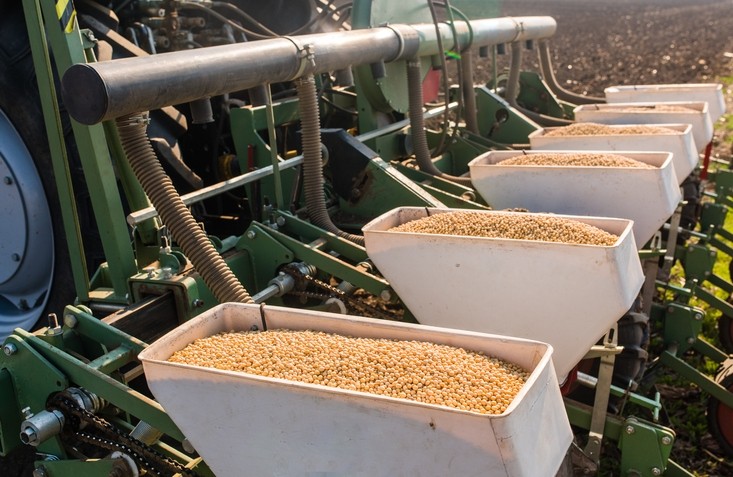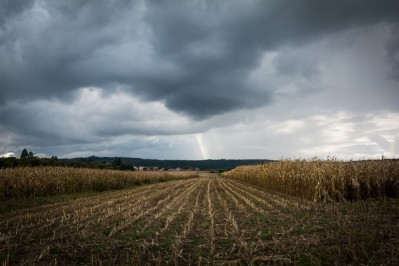US corn sees price bump following acre tumble in WASDE report

The US Department of Agriculture (USDA) released details about global feed and crop production and use on Tuesday [June 12] in the World Agriculture Supply and Demand Estimate (WASDE) report.
Corn markets saw a price bump following the release of the report, said Chad Hart, associate professor of economics, crop markets specialist and Extension economist with Iowa State University.
Corn prices rose about $0.10 to $0.12 after it was published.
“For the feed users this points to 2019/2020 being more challenging than the past 5 or 6 years,” he told FeedNavigator. “We’re going to see higher feed costs.”
It could be time for feed users to see what ingredient bargains they can find, he said. Adding, “We fall back to the law of one price – when you see the cost for one feed ingredient move up the others move up too.”
“We were expecting USDA to eventually downgrade the size of the corn crop, but traders were a little caught off guard by how much [it was reduced] in this report,” Hart said regarding the market response. “The reduction on the acreage and the yield – it was a quite dramatic pull back this early in the season from USDA.”
It is anticipated that the acreage could fall again when the acres planted report is released at the end of the month, he said.
“They’ve pulled three million acres out and the expectation is they’ll pull more.”
It is unclear at this point how many acres will move from corn to another crop like soybeans or if feed crop producers will consider acres to have faced prevented planting and seek insurance compensation, he said.
“Right now, we’re trying to get our hands around how much goes to strictly prevented planting and I think we’ve already had a fair amount move that way,” he added.
“Weather conditions haven’t been even close to good for a lot of planting progress and looking at the market potential of the crop – for corn in mid-June that’s pushing pretty hard,” he said. Even soybeans may be starting to face yield loss from late planting, he added.
Corn use and yields
The 2019/20 corn outlook in the US calls for higher beginning stocks, raised imports along with a drop in feed and residual use, exports and production, the USDA said. Ending stocks also are predicted to drop.
Beginning stocks were raised to reflect a 100m-bushel drop in anticipated exports for the 2018/19 period stemming from “current outstanding sales and reduced US price competitiveness,” the department said.
However, corn production in 2019/20 is expected to fall 1.4bn bushels to about 13.7bn – the lowest level of production since 2015/16, the department said. Planting delays are predicted to reduce yield and have prevented some planting.
Lower supplies, however, are anticipated to reduce total use by about 425m bushels to 14.3bn based on feed use and exports, the department said. As supplies are expected to drop more than use, ending stocks were lowered to 1.7bn bushels.
Season average farm price has been increased $0.50 to $3.80 per bushel, the department said.
With the delay in corn planting, some feed crop organizations are promoting the planting of other grains including sorghum.
The National Sorghum Producers (NSP) organization has suggested that the feed grain could be planted in place of delayed corn acres.
There would be a need to consider the variety of the plant used as more northern areas might need an early maturing variety while parts of the Corn Belt could use a medium, or early-medium strain, said Brent Bean, agronomist with the Sorghum Checkoff.
But sorghum can be planted through the end of June if not into early July depending on variety and region.
Although the plant may be associated with drought production because it is tolerant of low-water situations, it will provide a larger yield with more rainfall, he told us.
Additionally, it may provide a production boost to the following crop – especially if there is a rotation to a broadleaf crop like soybeans, he said.
“Any place that corn can be used sorghum can be used – fed to cattle, swine and poultry,” Bean said. “Poultry and swine really do like grain sorghum.
Global corn production also is anticipated to decline, but see increased trade, the USDA said. Ending stocks are predicted to be below earlier expectations.
Higher prices are expected to boost production in Argentina, and Russia saw an increase in planted area, but Canada is anticipated to see a drop in production following planting delays in Ontario, the department said.
Brazil is also expected to see a larger crop.
Overall, more corn exports are forecast for Argentina and Russia in 2019/20, the department said. However, in 2018/19 exports were increased for Brazil and Argentina.
Soybean considerations
In 2019/20 soybean beginning and ending stocks are expected to increase, the USDA said. Beginning stocks reflect a 75m bushel drop in predicted exports in 2018/19.
Poor weather conditions have delayed planting, but total production remains the same, the department said.
Soybean meal imports and exports are expected to increase in 2018/19, the department said.
However, the season average soybean price for 2019/20 is anticipated to increase $0.15 to $8.25 per bushel, based on corn prices, the USDA said. Soybean meal prices were up to $295 a short ton.
International soybean production is anticipated to drop based on smaller crops coming from Ukraine and Zambia, the department said. In 2019/20 both beginning and ending stocks are expected to fall.
Wheat production
Wheat supplies in the US are reduced for 2019/20 based on lower beginning stocks only slightly offset by increased production, the USDA said. Beginning stocks dropped based on higher exports in 2018/19.
Winter wheat production has been raised 6m bushels to 1.27bn, the department said. Total wheat production also was increased 5.8m bushels from earlier estimates.
Exports in 2019/20 are anticipated to be about 900m bushels with ending stocks dropping to 1.07bn bushels, the department said. However, feed and residual use were increased 50m bushels based on the drop in corn production.
The season-average farm price was increased $0.40 to $5.10 based on improved wheat future prices and the anticipation of lower 2019/20 corn supplies.
Globally, 2019/20 wheat supplies were increased by 4.9m tons based on both higher beginning stocks and an increase in total production, the USDA said. Favorable weather is increasing production in Russia and Ukraine.
Global trade is forecast to grow by 0.8m tons from earlier estimates, the department said.
Exports from Russia and Ukraine are projected to be 37m tons and 19.5m tons, respectively. However, the EU is anticipated to see lower exports based on competition from the Black Sea region.
Higher anticipated feed, residual and food use are forecast to raise world consumption 3.6m tons, the department said. However, supply is set to outpace demand and ending stocks were raised by 1.3m tons.












